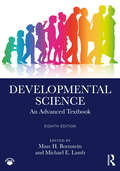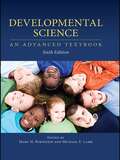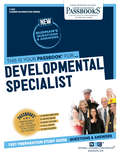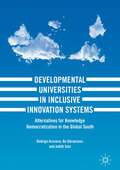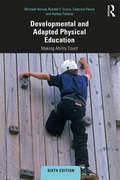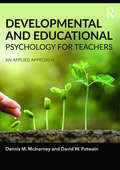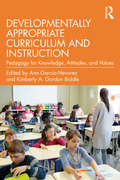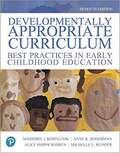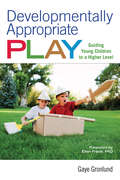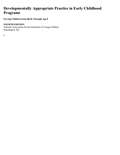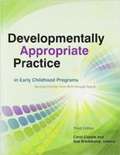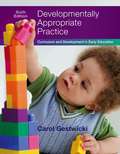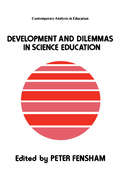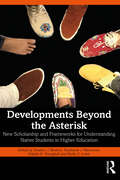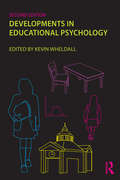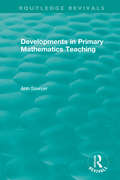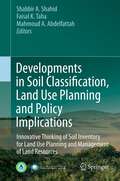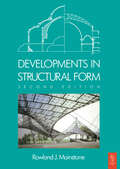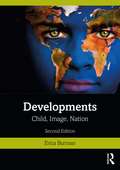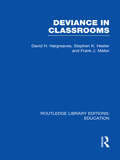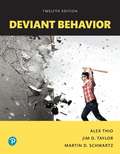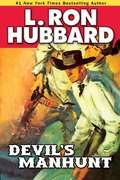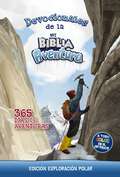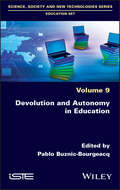- Table View
- List View
Developmental Science: An Advanced Textbook
by Marc H. Bornstein Michael E. LambDevelopmental Science: An Advanced Textbook is the most complete and up-to-date advanced introduction to the field available today. Since its initial publication, the key purpose of this advanced textbook has been to furnish inclusive developmental perspectives on all theoretical, methodological, and substantive areas in developmental science. This eighth edition is no exception, as it continues to underscore the dynamic and exciting status of contemporary developmental science.In this eighth edition, Marc H. Bornstein and Michael E. Lamb have invited international experts to prepare original, comprehensive, and topical treatments of all major areas of developmental science; they are masterfully woven into a single coherent volume. The substantive chapters cover essentials of their main topics, with close attention paid to cultural, lifespan, and applied perspectives. Many chapters in this eighth edition are new, and those carried forward from the seventh edition have been extensively revised. This volume therefore represents faithfully the current status of scholarly efforts in all aspects of developmental science.Ideal for advanced undergraduate and introductory graduate courses, this advanced textbook is accompanied by two sets of supplementary materials: pedagogy files for students include chapter outlines, things to think about before reading the chapters, glossaries, and suggested readings; and ancillary files for instructors include a PowerPoint deck of tables and figures, classroom assignments, essay questions, multiple-choice questions, and short-answer questions.
Developmental Science: An Advanced Textbook, Sixth Edition
by Marc H. Bornstein Michael E. LambNoted as one of the most comprehensive textbooks in the field, Developmental Science, 6th Edition introduces readers to all of areas in developmental psychology: neuroscience, genetics, perception, cognition, language, emotion, self, and social interaction. Each of the world-renowned contributors masterfully introduces the history and systems, methodologies, and measurement and analytic techniques used to understand the area of human development under review. The relevance of the field is illustrated through engaging applications in each chapter. As a whole, this highly-respected text illuminates substantive phenomena in developmental science, its applications across the life span, and its relevance to everyday life. Each chapter has been substantially revised for this new edition to reflect the current state of the field and the new edition is now accompanied by a website. Students and instructors will find chapter outlines, topics to think about before reading the chapters, a glossary, and suggested readings with active reference links on the website. Electronic access to the text's figures and tables, suggestions for classroom assignments and/or discussion, and a test bank with multiple-choice, short answer, and essay questions is limited to instructors only. Two new chapters highlight many modern developments. Each chapter features an introduction, up-to-date overviews of the field, summary and conclusion, and numerous classical and contemporary references. The book opens with an overview of developmental science -- its history and theory, the cultural orientation to thinking about human development, and the manner in which empirical research is designed, conducted, and analyzed. Part 2 focuses on the field's major substantive areas: neuroscience and genetics, physical and motor skills, perception, and cognitive and language development. Part 3 examines personality and social development within the context of the various relationships and situations in which developing individuals function and by which they are shaped. The book concludes with a new chapter on the latest applications of developmental science. Ways in which developmental thinking and research affect and are affected by practice and social policy are particularly emphasized. Used primarily as a graduate level text for courses on developmental psychology/science, life span, and/or human development, the book can also be used at the advanced undergraduate level. Researchers interested in staying abreast of the latest developments in the field also appreciate the book's comprehensive nature.
Developmental Specialist: Passbooks Study Guide (Career Examination Series #C-923)
by National Learning CorporationThe Developmental Specialist Passbook® prepares you for your test by allowing you to take practice exams in the subjects you need to study. It provides hundreds of questions and answers in the areas that will likely be covered on your upcoming exam, including but not limited to: developing and implementing habilitation plans; interpreting and maintaining client records; understanding individuals with developmental disabilities; and more.
Developmental Universities in Inclusive Innovation Systems
by Bo Göransson Rodrigo Arocena Judith SutzThis book analyzes the current trends in the production, dissemination, and use of knowledge which contribute to social inequalities, especially in the Global South. The aim of the text is to explore the possibilities of active involvement by universities in the democratization of knowledge - a process by which people will be able to more easily acquire and utilize knowledge, as well as the results and benefits of research and development. Combining higher education, research, and knowledge utilization is what universities should be doing. When they efficiently contribute to overcoming inequality and underdevelopment, they may be considered developmental universities. They should not function in solitude with privileged elites alone, but in the context of "inclusive innovation systems. "
Developmental and Adapted Physical Education: Making Ability Count
by Michael Horvat Ronald V. Croce Caterina Pesce Ashley Eason FallaizeNow in a fully revised and updated 6th edition, reflecting changes in legislation and cutting-edge research, this is a complete introduction to adapted physical education, from the underpinning science to practical teaching strategies and program design. The book covers a broader range of disabilities, developmental disorders, and health conditions than any other textbook and includes brand new material on developmental coordination disorders and cognitive development. Full of teaching and coaching strategies and techniques, it introduces scientific fundamentals, key legislation, and best practice in designing effective programs. It encourages the reader to consider the individual before the disability and to focus on what learners can do rather than what they can’t. This is an essential reference for teachers, coaches, or exercise professionals working with children with disabilities. It is also an invaluable resource for undergraduate or postgraduate students of adapted physical education, kinesiology, physical education, physical therapy, exercise science, athletic training, or sports coaching. The new edition features updated online resources, including PowerPoint slides, web links, an example syllabus, and quizzes.
Developmental and Educational Psychology for Teachers: An applied approach
by Dennis McInerney David PutwainDevelopmental and Educational Psychology for Teachers brings together a range of evidence drawn from psychology to answer a number of critical educational questions, from basic questions of readiness – for example, when is a child ready for school, through to more complex matters, such as how does a teacher understand and promote good peer relationships in their classroom? The answers to these and other questions discussed draw here on the interplay between a teachers’ craft expertise and their knowledge of evidence and theory from developmental and educational psychology. Presenting a range of classic theories and contemporary research to help readers understand what the key issues are for teachers and other professionals, this book aides informed educational decisions in situations such as: inclusion, ability grouping, sex differences, developing creativity, home and peer influences on learning, and developing effective learners. Teachers in early years, primary and secondary settings are routinely faced with questions regarding the development of children. This not only relates to the planning and delivery of lessons, but also to the mental and physical wellbeing of the children and adolescents that they teach. The pedagogical features of this book are accessible and clearly presented, including focus questions that direct the reader’s attention to key issues, activity posts that point the reader to meaningful and relevant research and show the practical applications of material covered, and extension material that gives depth to many of the topics covered. This book aims to inform the practice of both in-service and trainee teachers, addressing issues that are relevant to their practice. With no other detailed and accessible text presenting this evidence and theory specifically for an audience of practicing and trainee teachers currently on the market, this book will be of essential reading to practicing and trainee teachers for early years, primary and secondary education and other related educational contexts such as educational psychologists, counsellors, paediatric and child doctors and nurses.
Developmentally Appropriate Curriculum and Instruction: Pedagogy for Knowledge, Attitudes, and Values
by Ana Garcia-Nevarez and Kimberly A. Gordon BiddleThis timely and accessible volume explores how our understanding of research in child development can help cultivate the knowledge, skills, and attitudes children need for informed and thoughtful participation in society by viewing the curriculum through a developmental lens. Biddle and Garcia-Nevarez cover a range of key topics including characteristics of physical, cognitive, and psychosocial development of children; heritable and environmental influences on children’s developing self; language and literacy development; mathematical cognition; growth mindsets; and evidence-based positive behavioral interventions and supports. The expert team of contributors offers an advanced exploration of developmental science and how this applies to learning and education in order to create inclusive environments that support children with a range of abilities, including those with the most significant medical, intellectual, and developmental delays. Each chapter contains boxes exploring how the topic relates to the themes of "Promoting Social and Emotional Competence Theory," "Research to Practice Connection," "Common Core and Other Standards," and "Social Justice and Diversity," ensuring comprehensive and consistent coverage across the volume. Developmentally Appropriate Curriculum and Instruction will be essential reading for students of child development and education, as well as educators and those in teacher training who are interested in how theory and research can be effectively harnessed to improve children’s outcomes.
Developmentally Appropriate Curriculum: Best Practices in Early Childhood Education
by Marjorie Kostelnik Anne Soderman Alice Whiren Michelle RupiperDevelopmentally Appropriate Curriculum: Best Practices in Early Childhood Education is an all-in-one guide that brings together everything pre-service teachers need to implement an integrated, developmental approach to curriculum-based instruction. <p><p> The 7th Edition addresses all aspects of classroom life–conceptualization, planning, implementation, and evaluation–for children ages three through eight. This comprehensive, cohesive approach emphasizes the “how” of curriculum development, as well as the “what and why.” With practical, research-based guidelines, sample activities and lesson plans for each curriculum domain, and a focus on teaching methods, readers have the tools they need to translate theory into age-appropriate practice that accommodates individual, social, and cultural differences.
Developmentally Appropriate Play
by Gaye GronlundEnhance the depth and richness of children's play. Developmentally appropriate play is complex, long-lasting, and all-engaging for children. It requires facilitation and guidance, thoughtful planning, and attention to the environment and materials. Developmentally Appropriate Play follows the new Developmentally Appropriate Practice guidelines from the National Association for the Education of Young Children (NAEYC) and includes information to help you:Identify and plan purposeful playGuide children to make choicesInteract with children to enhance playProvoke children into more complex playAdd representation to further enrich playIncorporate standards into play
Developmentally Appropriate Practice In Early Childhood Programs: Serving Children From Birth Through Age 8
by Sue Bredekamp Barbara Willer Susan Friedman Brian L. Wright Marie L. MastersonDevelopmentally appropriate practice is the foundation on which quality early learning is built. The fourth edition of this classic, influential text addresses developmentally appropriate practice within the context of the ever-changing and evolving world of early childhood education. With a strong focus on equity and teaching and supporting all children, it underscores the importance of social, cultural, and historical contexts of development.
Developmentally Appropriate Practice in Early Childhood Programs: Serving Children from Birth through Age 8
by Carol Copple Sue BredekampThe core of this book is eight chapters that address the periods of early childhood--The Infant and Toddler Years (Ages 0-3); The Preschool Years (Ages 3-5), The Kindergarten Year (Ages 5-6), and The Primary Grades (Ages 6-8).
Developmentally Appropriate Practice: Curriculum and Development in Early Education (Sixth Edition)
by Carol GestwickiThoughtful and comprehensive, DEVELOPMENTALLY APPROPRIATE PRACTICE: CURRICULUM AND DEVELOPMENT IN EARLY EDUCATION, 6th Edition, is designed to meet the needs of new early childhood students as well as experienced teachers, professionals, and parents. It provides you with an overview of the concepts and theoretical foundations of appropriate practices in every developmental domain and discusses the practical implications for teachers and caregivers. The text reflects the NAEYC position statement on Developmentally Appropriate Practice and includes content on aligning early childhood teaching practices with national education standards, in addition to many interesting anecdotes, vignettes, interactive features, and applications to help you understand and apply the material. The text also shows you how to be effective no matter what curriculum model is used in your center, whether Reggio Emilia, Montessori, High Scope, Creative Curriculum, Bank Street, Waldorf, or any other.
Developments And Dilemmas In Science Education (Contemporary Analysis In Education Series. Open University Set Text Ser. #Vol. 23)
by Peter Fensham Monash University, Australia.A summary of the strengths and weaknesses in present practices of science education in schools, and of research in science education. Annotation copyright Book News, Inc. Portland, Or.
Developments Beyond the Asterisk: New Scholarship and Frameworks for Understanding Native Students in Higher Education
by Heather J. Shotton Shelly C. Lowe Stephanie J. Waterman Natalie R. YoungbullThis edited volume serves as a follow-up to Beyond the Asterisk: Understanding Native Students in Higher Education, focusing on new scholarship, continued conversations, and growth in the field of Indigenous higher education. The landscape of higher education has changed significantly over the past decade; likewise, Indigenous higher education has grown into its own respective field with emerging scholarship that is written for and by Indigenous people. This book focuses on this growth, revisiting relevant topics in Indigenous higher education, while adding new and expanded research and insight from emerging scholars and practitioners, including chapters on Indigenous LGBTQIA+ and Two-Spirt students and Native Hawaiian and Pacific Islanders. The voices of Indigenous scholars who are challenging the status quo in higher education have grown louder, and institutions and organizations have increasingly begun to respond. This volume is essential to continued conversations in Indigenous higher education and invites current, emerging, and future scholars to carry the conversation forward in respectful, responsible, and relational ways.
Developments in Educational Psychology: How Far Have We Come In 25 Years?
by Kevin WheldallReview comment on the first edition "Wheldall asks himself and his readers what has transpired within the field of educational psychology … and what its relevance actually is for teaching, learning and education. As such it is a ‘must read’ for all educational psychologists, students of educational psychology, teachers and teacher trainers." Professor Paul Kirschner, Open Universiteit, British Journal of Educational Technology What is the relevance of educational psychology in the twenty first century? In this collection of essays, leading educational psychologists reflect on the seminal developments which have been made in the field over the past twenty five years or so and assess how far we have progressed. Given a broad and personal remit to address a range of issues, the contributors review and critique a variety of topics, including: intelligence; communication; family environments; individual differences; reading; peer learning; classroom behaviour; and higher education. Providing provocative and challenging insights into the state of contemporary educational psychology, the contributors acknowledge throughout the successes and progression in the field, but with a critical edge and a challenge being thrown down to psychologists of education to make study more seriously informed and as a consequence, reformed. Now in its second edition this compelling text for students and researchers is thoroughly updated and includes four new chapters.
Developments in Primary Mathematics Teaching (Routledge Revivals)
by Ann SawyerThis book, originally published in 1993, addresses the issues surrounding the teaching of mathematics in primary school at the time. The author considers the issues that had arisen through the introduction of the National Curriculum, both in terms of the current "state of the art" and new developments.
Developments in Soil Classification, Land Use Planning and Policy Implications
by Shabbir A. Shahid Mahmoud A. Abdelfattah Faisal K. TahaAs the world's population continues to expand, maintaining and indeed increasing agricultural productivity is more important than ever, though it is also more difficult than ever in the face of changing weather patterns that in some cases are leading to aridity and desertification. The absence of scientific soil inventories, especially in arid areas, leads to mistaken decisions about soil use that, in the end, reduce a region's capacity to feed its population, or to guarantee a clean water supply. Greater efficiency in soil use is possible when these resources are properly classified using international standards. Focusing on arid regions, this volume details soil classification from many countries. It is only once this information is properly assimilated by policymakers it becomes a foundation for informed decisions in land use planning for rational and sustainable uses.
Developments in Structural Form
by Rowland MainstoneIn the critically acclaimed first edition of this book, Mainstone offered a brilliant and highly original account of the structural developments that have made possible the achievements of architects and bridge builders throughout history.In this extensively revised and expanded new edition, now available in paperback, new insights and a full coverage of recent developments in both design and construction are incorporated. The book identifies features that distinguish the forms built by man from those shaped by nature and discusses the physical and other constraints on the choices that can be made. It then looks in turn at all the elementary forms - arches, domes, beams, slabs and the like - which combine into the more complex forms of complete structures, and at the different classes of the complete forms themselves. The development of each form is traced chronologically, but with an emphasis less on the chronology than on the problems that designers have continually faced in trying to serve new ends with limited means or to serve old ones in new ways. The book concludes with a chapter on the processes of design, showing how the designer's freedom of choice has been widened by a growing understanding of structural behaviour.
Developments: Child, Image, Nation
by Erica BurmanHow does developmental psychology connect with (what used to be called) the developing world? What do cultural representations indicate about the contemporary politics of childhood? How is concern about child sexual exploitation linked to wider securitization anxieties? In other words: what is the political economy of childhood, and how is this affectively organized? This new edition of Developments: Child, Image, Nation, fully updated, is a key conceptual intervention and resource, reflecting further on the contexts and frameworks that tie children to national and international agendas. A companion volume to Burman’s Deconstructing Developmental Psychology (third edition, 2017) this volume helps explain why questions around children and childhood, including their safety, welfare, their interests, abilities, sexualities and their violence, have so preoccupied the late twentieth and twenty-first centuries, showing how the frames for these concerns have extended beyond their Euro-US contexts of origination. In this completely revised edition, Burman explores changing debates and contexts, offering resources for interpreting continuities and shifts in the complex terrain connecting children and development. Through reflection on an increasingly globalised, marketised world, that prolongs previous colonial and gendered dynamics in new and even more insidious ways, Developments analyses the conceptual paradigms shaping how we think about and work with children, and recommends strategies for changing them. Drawing in particular on feminist and post-development literatures, as well as original and detailed engagement with social theory, it illustrates how and why reconceptualising notions of individual and human development, including those informing models of children’s rights and interests, is needed to foster more just and equitable forms of professional practice with children and their families. Burman offers an important contribution to a set of urgent debates engaging theory and method, policy and practice across all the disciplines that work with, or lay claim to, children’s interests. A persuasive set of arguments about childhood, culture and professional practice, Developments is an invaluable resource to teachers and students in psychology, childhood studies, and education as well as researchers in gender studies.
Deviance in Classrooms (Routledge Library Editions: Education)
by Stephen Hester David H Hargreaves Frank J MellorWhen originally published this book reported the first major application of ‘labelling theory’ to deviance in classrooms. The authors explore the nature of classroom rules, show how they constitute a pervasive feature of the classroom, and examine the ways in which teachers use these rules as grounds for imputing ‘deviance’ to pupils. A theory of social typing is developed to show how teachers come to define certain pupils as deviant persons such as ‘troublemakers’ and several case-studies are used to document this analysis. Finally, the teachers’ reactions to disruptive classroom conduct are examined as complex strategic attempts at social control in the classroom. The book has a double focus on deviance theory and the process of teaching.
Deviant Behavior
by Jim Taylor Martin Schwartz Alex ThioThis new edition of Deviant Behavior is designed to make teaching and learning as interesting and rewarding as possible. Deviant behavior is already by itself an exciting subject, but the authors have tried to make it more exciting with a simple, lively, and engaging style of writing. No matter how complex and dry the theories and data about deviance may appear in scholarly journals, government reports, and most books, here they are presented in a fresh, straightforward style, with vivid and real-life contexts. In addition, stimulating, ironic, and thought- provoking remarks are often thrown in to make the book come alive.
Devil's Manhunt
by L. Ron HubbardSaddle up with this riveting tale. Young Tim Beckdolt had been working Desperation Peak in Arizona for eight long, treacherous months before striking a rich seam of gold. Now, after three months of hard, grueling labor, he's stockpiled more than $175,000 of gold ore, and his dreams of wealth are about to be realized . . . that is until the loutish Swedish giant Sven and the foppish Virginian killer Bonnet, arrive to jump his claim. Forced by gunpoint to mine the remainder of the gold for this villainous pair, Tim manages to escape into the surrounding wilderness, only to be hunted like an animal through vicious terrain with no weapons to defend himself or food to sustain him. ALSO INCLUDES THE WESTERN STORIES "JOHNNY, THE TOWN TAMER" AND "STRANGER IN TOWN" "With the flair of a Louis L'Amour or Zane Grey." --True West*An International Book Awards Winner
Devocionales de la Biblia: 365 de aventura (Adventure Bible)
by Zondervan¡Toma tu abrigo y tu brújula y prepárate para la aventura! El nuevo libro ilustrado Devocionales de la Biblia: Aventura NVI: Edición exploración polar lleva a los niños a una emocionante y enriquecedora búsqueda. Este devocional de 365 días está lleno de emocionantes historias diarias e incluye índices temáticos y de las Escrituras. ¡Los temas devocionales abarcan la autoestima, el coraje, la amistad y muchos otros! Los niños y niñas aprenderán más acerca de Dios y la Biblia y se sentirán inspirados para vivir una vida de fe; la mayor aventura de todas. Es un complement a la Biblia Aventura NVI: parte del destacado éxito de ventas de Biblias infantiles.Este devocional presenta un interior a todo color.
Devolution and Autonomy in Education
by Pablo Buznic-BourgeacqAllowing learners to take some responsibility may seem obvious yet what is actually afforded to them, and how this process works, remains difficult to grasp. It is therefore essential to study the real objects of devolution and the roles played by the subjects involved. Devolution and Autonomy in Education questions the concept of devolution, introduced into the field of education in the 1980s from disciplinary didactics, and described in Guy Brousseau’s Theory of Didactical Situations in Mathematics as: the act by which the teacher makes the student take responsibility for a learning situation (adidactic) or problem and accepts the consequences of this transfer.The book revisits this concept through a variety of subject areas (mathematics, French, physical education, life sciences, digital learning, play) and educational domains (teaching, training, facilitation). Using these intersecting perspectives, this book also examines the purpose and timeline of the core process for thinking about autonomy and empowerment in education.
Devotions for the Beach . . . and Days You Wish You Were There
by Thomas NelsonDig your feet in the sand and let the water cool your toes as you escape into the beauty of God’s seaside creations, and hear His voice more clearly than perhaps anywhere else. There’s nothing quite like the warmth and relaxation of the beach—away from the stresses of the world and into a place of peace and refreshment. Devotions for the Beach is the gentle breeze that takes you there, to see the majesty of God and to open your heart and soul to the One who created it all. These ninety devotions explore the parallels of life with the elements of the shore to help you see God, to find hope, to draw strength, and to rest in the comfort of His arms throughout your day. Included are striking photographs with a fresh, contemporary design for timeless appeal. Every woman will want a copy of this book as a gentle reminder of days at the beach and the call of God’s love.
